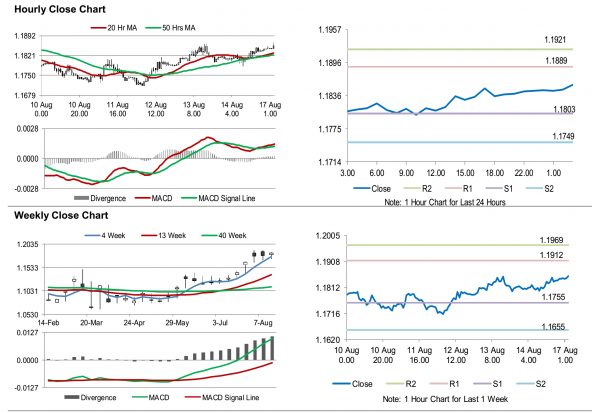For the 24 hours to 23:00 GMT, the EUR rose 0.19% against the USD and closed at 1.1839 on Friday.
On the macro front, Euro-zone’s gross domestic product plunged 12.1% on quarterly basis in 2Q 2020, recording its sharpest contraction since 1995 and compared to a fall of 3.6% in the prior quarter. Meanwhile, trade surplus widened to €21.2 billion in June, more than expectations for surplus €12.6 billion and compared to a surplus €9.4 billion in the earlier month.
In the US, retail sales rose 1.2% on a monthly basis in July, less than market forecast for a rise of 1.9% and compared to a revised rise of 8.4% in the prior month. Additionally, business inventories fell 1.1% in June, compared to a fall of 2.3% in the prior month. Meanwhile, the Michigan consumer sentiment index unexpectedly climbed to 72.8 in August, defying market forecast for a drop to a level of 72.0 and compared to a reading of 72.5 in the previous month. Moreover, industrial production rose 3.0% on a monthly basis in July, in line with market expectations and compared to a revised rise of 5.7% in the prior month. Further, manufacturing production rose 3.4% on a monthly basis in July, compared to a revised rise of 7.4% in the prior month.
In the Asian session, at GMT0300, the pair is trading at 1.1856, with the EUR trading 0.14% higher against the USD from Friday’s close.
The pair is expected to find support at 1.1803, and a fall through could take it to the next support level of 1.1749. The pair is expected to find its first resistance at 1.1889, and a rise through could take it to the next resistance level of 1.1921.
In absence of crucial macroeconomic releases in the Euro-zone today, investors would keep a close watch on the US NY Empire State manufacturing index and the NAHB housing market index, both for August, slated to release later today.
The currency pair is trading above its 20 Hr and 50 Hr moving averages.















